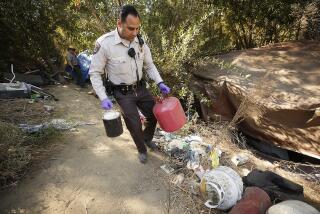County Raises Charges for Paramedics on Catalina Island : Budget: City of Avalon would have to pay 10 times more than the current $46,000 annual fee for critical medical and lifeguard services. Officials are studying other options, but those are costly, too.
Residents of Santa Catalina Island have recoiled at the news that they may lose their Los Angeles County paramedics unless they agree to pay 10 times more than they do now for the service.
Avalon, the islandâs only city, has been paying $46,000 annually to the County Department of Beaches and Harbors for paramedic and lifeguard service. But now the financially strapped county wants to increase the annual charge to $463,000, and city officials are puzzled over how to foot the bill.
The proposed increase served notice on this tranquil isle 26 miles offshore that it is not insulated from county budget cuts.
Indeed, Catalinaâs status as an island makes the paramedic problem more critical, since the community has no adjacent cities or nearby private ambulance services to turn to for paramedic help, said Avalon City Manager Chuck Prince.
âWhat you have to understand is that, while weâre in Los Angeles County and we can see Palos Verdes at night, Avalon is as isolated as any mountain community in California,â Prince said.
The city is studying whether it could train its own paramedics or obtain services elsewhere. A town meeting on the matter is planned for next month, and the City Council could make a decision soon afterward on how it will deal with the problem.
Avalon is the only city that contracts with the Department of Beaches and Harbors for paramedic services.
Under that arrangement, four paramedics are stationed in Avalon and three at the so-called âisthmus,â the narrow section of the island.
The contract also covers four county lifeguards who work in Avalon during the tourist season from mid-June to mid-September. Those lifeguards would also leave if Avalon dropped its county contract, but it is the paramedics that concern people most.
Because the sole hospital has only 12 beds and lacks services for acutely ill patients, paramedics have played an especially important role on the island.
âThe backbone of the medical care on that island has been borne by the paramedics,â said Randy DeGregori, assistant chief lifeguard for the Department of Beaches and Harbors.
Paramedics respond to virtually all medical calls on the island. They help transport patients to Avalon Municipal Hospital or to larger medical centers âovertown,â which is how residents refer to the mainland.
DeGregori stresses the importance of keeping paramedics on Catalina, pointing out that their training permits them to do procedures that city emergency medical technicians cannot, such as administering drugs and setting up intravenous infusions.
Such procedures can prove crucial in emergency calls ranging from heart attacks to severe allergic reaction to bee stings, he said.
Three of the seven island paramedics have 60 yearsâ combined experience on Catalina, DeGregori said.
âOur people not only go over there to do the job, they live there,â he said. âTheyâre part of the community. They know a lot about the people. They know a lot about the types of accidents over there.â
With a 1993-94 budget of $10 million, city officials are wincing at the countyâs $463,000 bill.
And paramedic funding is not the only medical problem confronting the city, which has already agreed to pump $520,000 this year into the Avalon Municipal Hospital in hopes of keeping its doors open.
With money so tight, Avalon is searching for alternative ways to provide paramedic care, perhaps by training its firefighters to serve as paramedics. But that initially would cost the city more than contracting with the county because of training expenses, Prince wrote in a memorandum last week.
Simply hiring its own paramedics would cost the city about the same as the county contract, but the city would have to establish ties to a base hospital on the mainland equipped to deal with emergencies, Prince reported. And enlisting paramedics through private ambulance companies could cost even more, as much as $500,000 to $600,000 a year, he said.
Prince said the city is trying to scrutinize exactly how medical care would be affected if the county paramedics were no longer available.
âWhat it really is going to come down to,â Prince said, âis a community decision on whether it wants to continue that service and pay for the actual cost.â
More to Read
Sign up for Essential California
The most important California stories and recommendations in your inbox every morning.
You may occasionally receive promotional content from the Los Angeles Times.










